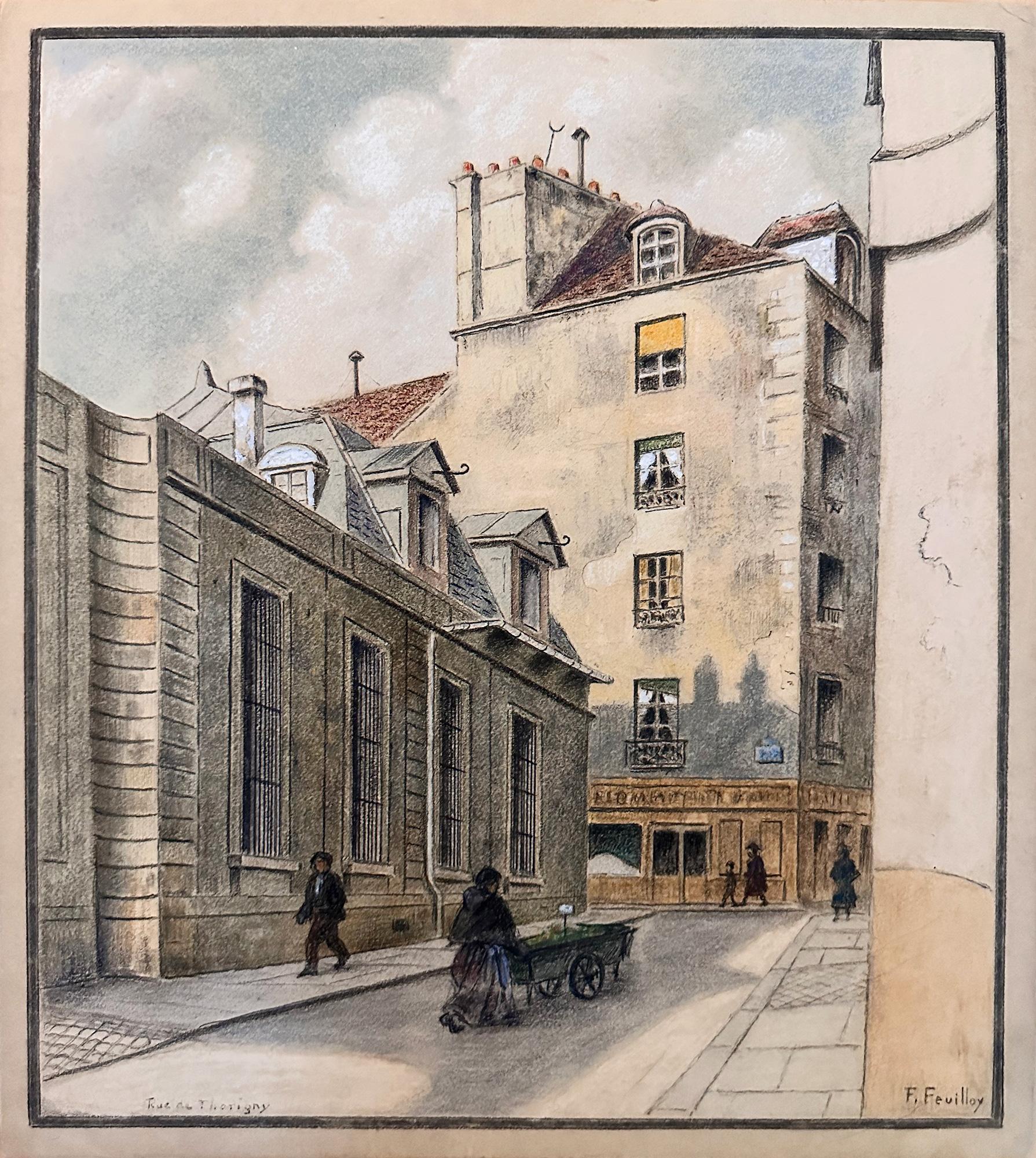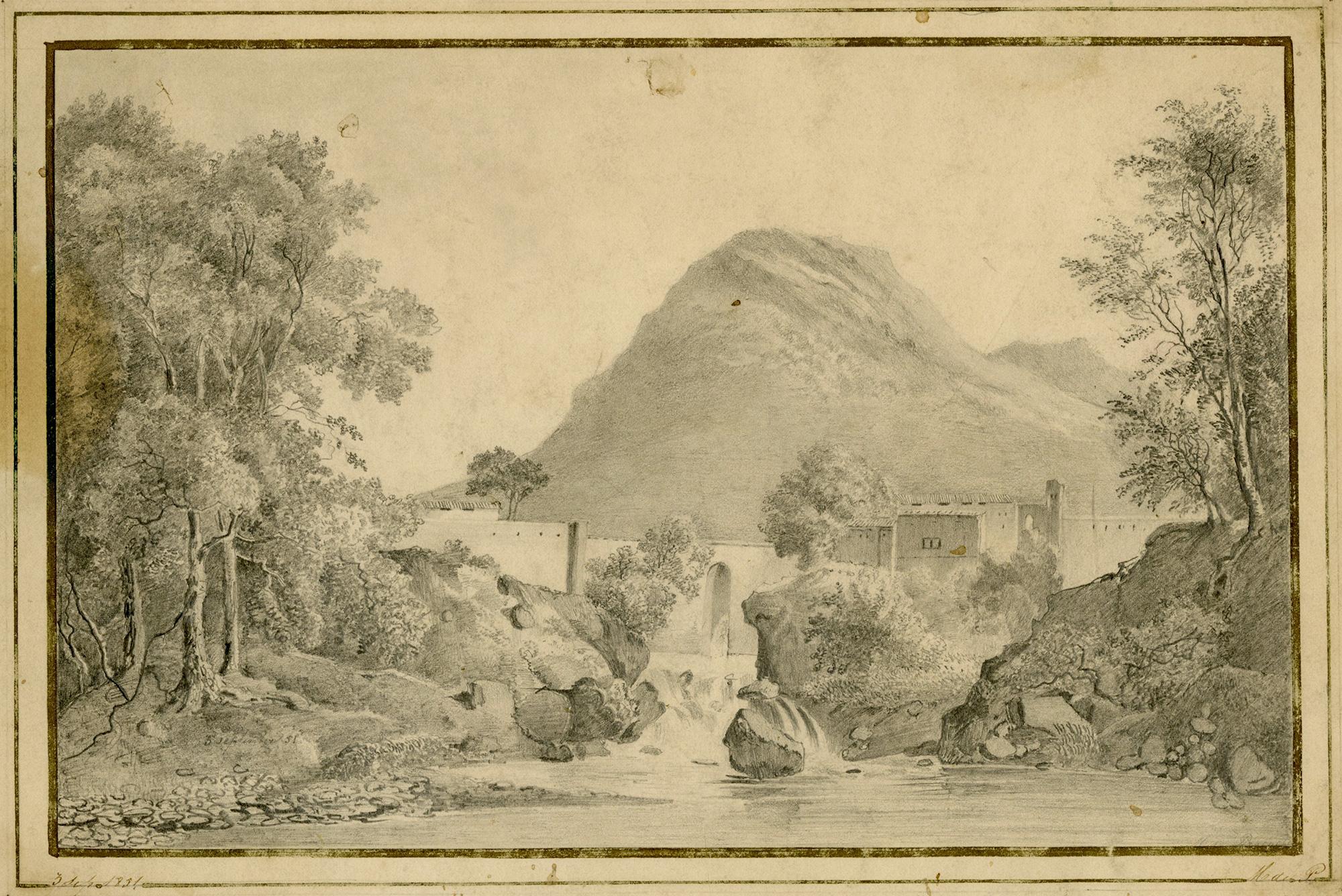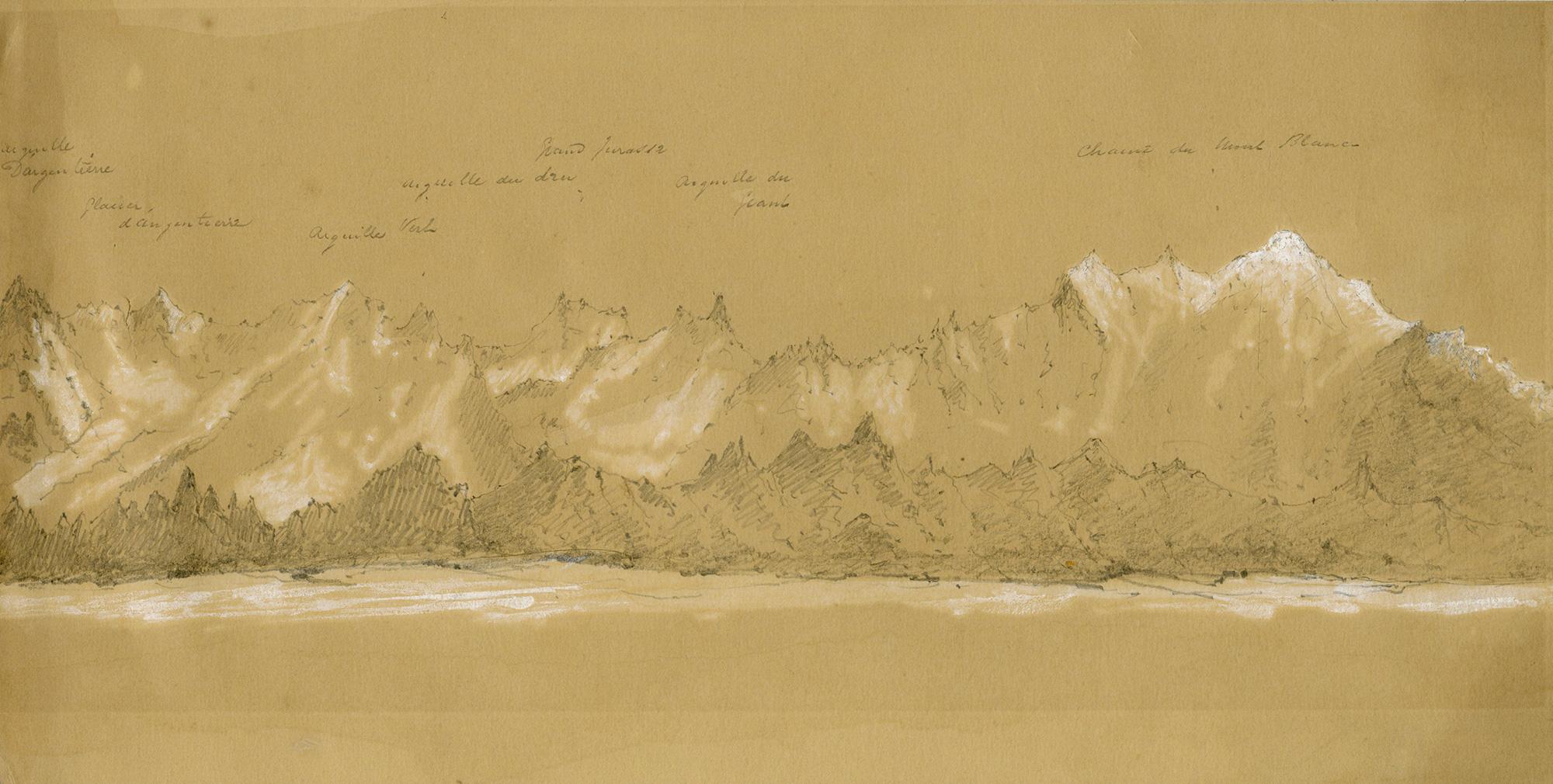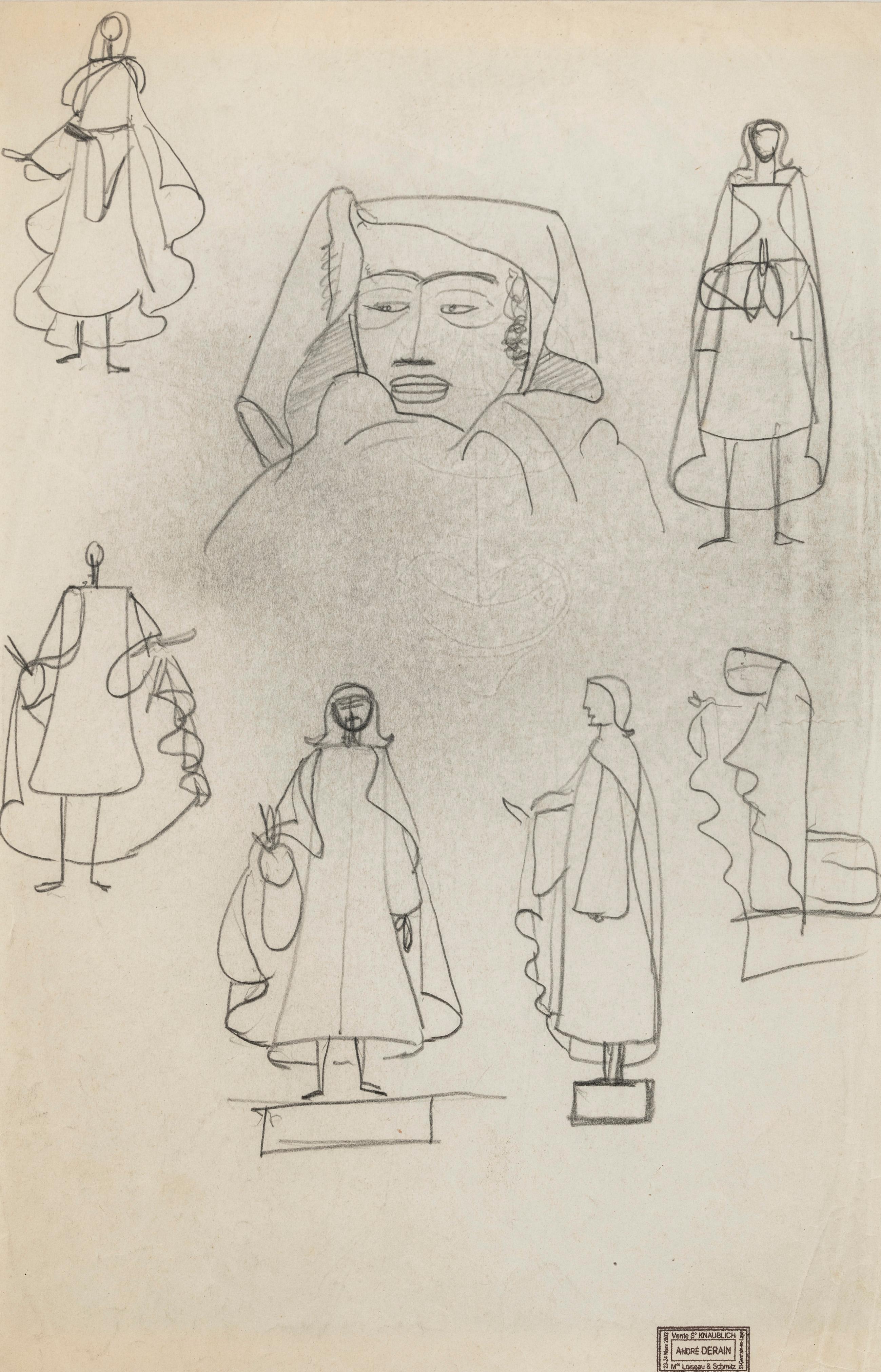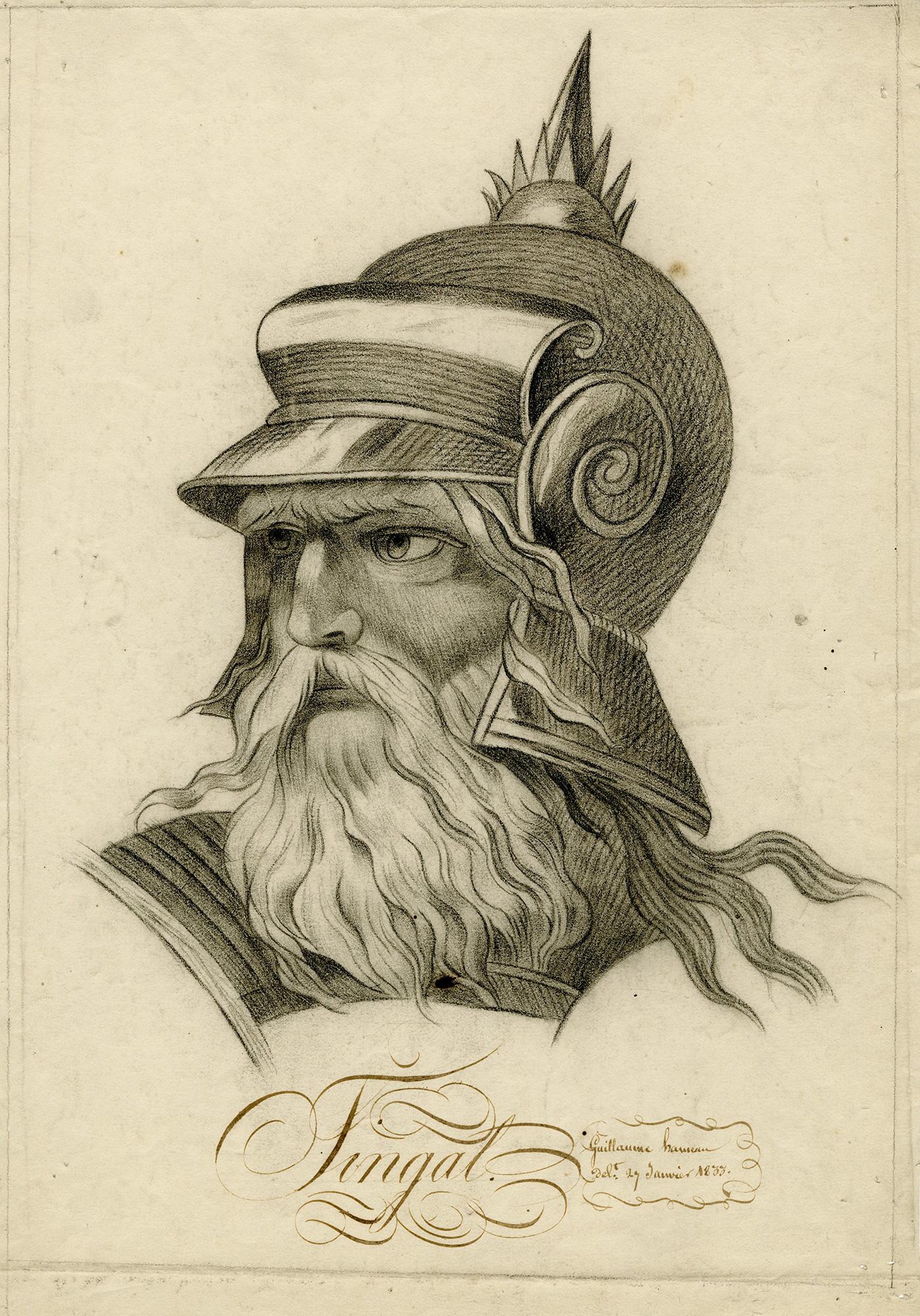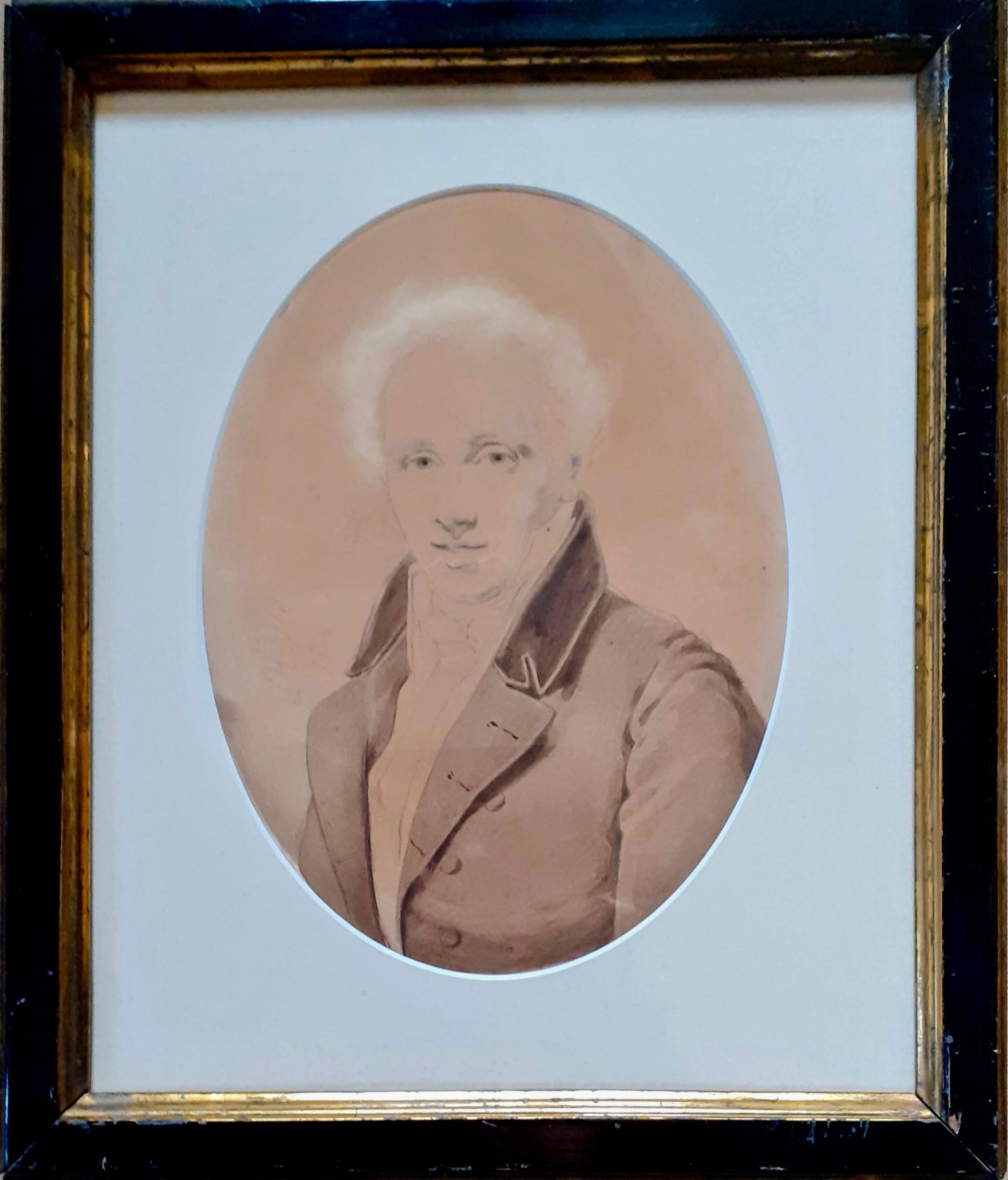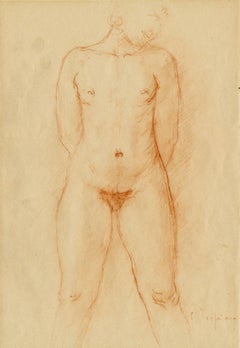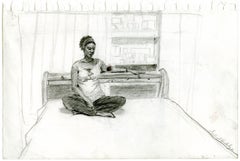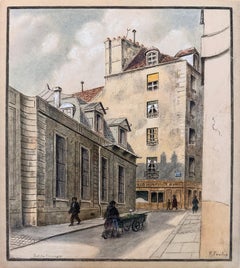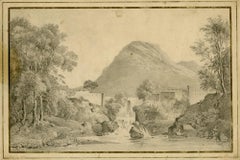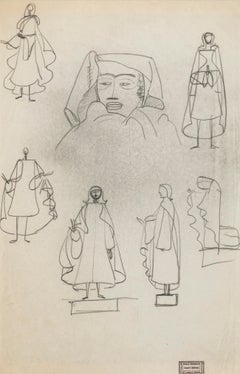Artículos similares a Untitled (Standing man with umbrella behind)
¿Quieres más imágenes o vídeos?
Solicita imágenes o vídeos adicionales al vendedor
1 de 5
Charles MaurinUntitled (Standing man with umbrella behind)c. 1890
c. 1890
Acerca del artículo
Untitled (Standing man with umbrella behind)
Graphite on paper, c. 1890's
Unsigned
Provenance: Estate of the Artist
Lucien Goldschmidt (1912-1992), noted art
dealer and scholar on Maurin
From the artist's sketchbook/record book, with the typeface number "561"
Image size: 7 7/8 x 6 1/4 inches
Condition: Good, tipped to support sheet
Charles Maurin
le puy-en-velay 1856 - grasse 1914
Biography
Having won the art scholarship known as the Prix Crozatier in 1875, Charles Maurin entered the Ecole des Beaux-Arts in Paris, studying with Jules Lefèbvre and Gustave Boulanger, and with Rodolphe Julian at the Académie Julian. He first exhibited at the Salon des Artistes Français in 1882, where he showed a pair of portraits, one of which gained an honourable mention. He continued to exhibit at the Salon des Artistes Français until 1890. He participated in the Salon des Indépendants for the first time in 1887, showing a number of paintings, drawings and engravings that were admired by, among others, Edgar Degas. As an artist, he worked in a variety of styles, the most distinctive being a sort of Symbolism evident in a range of allegorical subjects that he treated.
Maurin had a lifelong interest in the depiction of the female nude, and, like Degas and Mary Cassatt, was fond of portraying women at intimate moments of their daily routine. He also produced a handful of splendid portraits, mainly in the 1880s and 1890s, of friends, patrons and fellow artists including Georges Seurat and Rupert Carabin, as well as drawings and pastels of café, theatre and street scenes. Around 1885 he took up an appointment as a professor at the Académie Julian, where he met Félix Vallotton, who became a close friend. Another good friend was Henri de Toulouse-Lautrec, with whom Maurin shared an exhibition in 1893 at the Galerie Boussod et Valadon in Paris. It was there that, at the urging of Degas, the collector Henry Laurent began to acquire Maurin’s work, eventually becoming his foremost patron and collector.
The 1890s found Maurin enjoying a moderately successful career, with one-man shows with Ambroise Vollard in 1895 and at Edmond Sagot in 1899. He received a commission from the State for a painting of Maternité (Motherhood); completed in 1893 and sent to the museum in his native town of Le Puy, the painting was soon regarded as one of the artist’s finest works. The previous year he took part in the inaugural Salon de la Rose + Croix, where he showed one of his largest and most important paintings; a monumental triptych entitled L’Aurore (Dawn). He also contributed works to the Salons de la Rose + Croix of 1895 and 1897. Maurin painted a series of large decorative panels of Tragedy, Dance and Music for the foyer of the municipal theatre in Le Puy in 1893, and for Sarah Bernhardt designed sets and costumes for Edmond Rostand’s La Princess Lointaine in 1895. He visited Holland, Belgium and England, and sent works to Le Libre Esthétique in Brussels in 1896 and 1897, and the Exhibition of International Art in London in 1898. A man of firm anarchist leanings, Maurin produced illustrations for the radical journal Le Temps nouveau, and published portrait prints of the French anarchists Louise Michel and François Koenigstein, known as Ravachol. In 1895 he was also commissioned to provide illustrations for the art and literary journal La Revue Blanche.
After 1900, however, Maurin’s output declined considerably, partly due to ill health, and the last years of his life were spent in Brittany and Provence, where he died in obscurity in 1914. His work was largely forgotten after his death, although a retrospective exhibition was held at the Galerie Bernheim-Jeune in Paris in 1921, while a monograph on his work by Ulysse Rouchon was published the following year. Although a significant collection of Maurin’s work is today in the collection of the Musée Crozatier in Le Puy-en-Velay, his paintings and drawings remain little represented in museums outside France.
As a draughtsman, Charles Maurin was equally adept in pastel, chalk and pencil, and was highly regarded by critics, collectors and fellow artists; his drawings were, for example, particularly esteemed by Degas, who compared his draughtsmanship to that of his own great hero, Ingres. An innovative artist, he invented a method of using an atomizer to spray pigment onto the surface of the paper to create what he termed ‘peintures au vaporisateur’; large, atmospheric watercolour landscapes of great subtlety and beauty. Maurin is perhaps best known today, however, as a gifted and prolific printmaker, and played an important role in the revival of colour etching and wood engraving in the 1890s. Like his paintings, many of his prints focus on the female nude, or the theme of mothers and children, and account for some of the artist’s most striking and individual works. Maurin also developed a number of new techniques and processes, particularly with regard to printing in colour. Some of his prints were published in editions of ten or less, however, and much of his graphic work remains very rare today.
Although long forgotten or ignored after his death, Charles Maurin’s eclectic oeuvre as a painter, printmaker and draughtsman remains one of the most distinctive of any artist in France in the late 19th century. The French scholar Jacques Foucart, writing in 1979, succinctly described the artist as ‘that curious and libertarian figure, so typical of the effervescent Paris of the Belle Epoque, an engraver of social customs comparable with Louis Legrand, a perfectionist and an inventive technician, a sensitive draughtsman à la Besnard, a friend of Lautrec and Valloton. He created some of the most extravagant humanitarian and ‘socialist’ visions of the fin-de-siècle, which he treated in a flexible and decorative ‘graphisme’ in the manner of Eugène Grasset, or even of De Feure...That an artist of such intriguing qualities – even though, as engraver of nudes, he does at times become rather tiresomely vulgar and commercial – and so representative of a period that was hungry to explore everything (it is often said that all modern art was contained in the years before 1914), has been the subject of neither an exhibition, since that of 1921 at Bernheim’s, nor of a monograph, certainly sets one thinking about the vagaries of Taste and about the nature of the present fashion for the art of 1900.’ In recent years, however, a revival of interest in Maurin’s remarkable body of work culminated in a major monographic exhibition, entitled Charles Maurin, un Symboliste du Réel, at the Musée Crozatier in the artist’s native town of Le Puy-en-Valey in 2006.
Courtesy Stephen Ongpin, London
- Creador:Charles Maurin (1856 - 1914, Francés)
- Año de creación:c. 1890
- Dimensiones:Altura: 20,02 cm (7,88 in)Anchura: 15,88 cm (6,25 in)
- Medio:
- Movimiento y estilo:
- Época:
- Estado:
- Ubicación de la galería:Fairlawn, OH
- Número de referencia:Vendedor: FA122631stDibs: LU14016413012
Sobre el vendedor
5,0
Vendedor reconocido
Estos prestigiosos vendedores son líderes del sector y representan el escalón más alto en cuanto a calidad y diseño de artículos.
Vendedor Oro
Vendedores premium que mantienen una calificación de +4,3 y tiempos de respuesta de 24 horas
Establecido en 1978
Vendedor de 1stDibs desde 2013
788 ventas en 1stDibs
Tiempo de respuesta usual: <1 hora
Asociaciones
International Fine Print Dealers Association
- EnvíoRecuperando presupuesto…Envío desde: Akron, OH
- Política de devolución
Partes de esta página se han traducido automáticamente. 1stDibs no puede garantizar la exactitud de las traducciones. El inglés es el idioma predeterminado de este sitio web.
Garantía de autenticidad
En el improbable caso de que haya algún problema con la autenticidad de un artículo, ponte en contacto con nosotros en un plazo de 1 año para recibir un reembolso total. DetallesGarantía de devolución de dinero
Si tu artículo no es como se describe, sufre daños durante el transporte o no llega, ponte en contacto con nosotros en un plazo de 7 días para recibir un reembolso total. DetallesCancelación dentro de las 24 horas
Tienes un período de gracia de 24 horas para reconsiderar tu compra, sin preguntas.Vendedores profesionales aprobados
Nuestros vendedores de primera clase deben cumplir estrictos estándares de servicio para mantener la integridad de nuestros anuncios.Garantía de igualación de precios
Si encuentras que un vendedor publicó el mismo artículo por un precio menor en otro lado, igualaremos ese precio.Entrega global de confianza
Nuestra red de transporte de primera ofrece opciones de envío especializado en todo el mundo, que incluye envío personalizado.Más de este vendedor
Ver todoNu (Desnudo Femenino de Pie)
Por Charles Despiau
Nu (Desnudo Femenino de Pie)
Tiza roja sobre papel tejido, c. 1925
Firmado abajo a la derecha por el artista, ver foto
Estado: Excelente
Tamaño de la imagen/hoja: 12 1/8 x 8 5/16 pu...
Categoría
Década de 1920, Escuela francesa, Dibujos y acuarelas de desnudos
Materiales
Tiza
Sin título
Bömmels perteneció a los cofundadores del grupo de artistas de Colonia Mülheimer Freiheit , del que también formaban parte Hans Peter Adamski , Walter Dahn , Jiří Georg Dokoupil , Ge...
Categoría
Década de 1980, Surrealista, Dibujos y acuarelas figurativos
Materiales
Grafito
1500 US$
Sin título (Estudio para Los Aéreos)
Por John Steuart Curry
Sin título (Estudio para Los Aéreos)
Grafito sobre papel, 1932
Firmado a lápiz abajo a la derecha: "John Steuart Curry".
Fechado 1932 a lápiz
Expuesto:
Schroeder Romero & Shredder,...
Categoría
Década de 1930, moderno estadounidense, Dibujos y acuarelas figurativos
Materiales
Grafito
Sin título (Letitia, embarazada de Sol Naciente)
Por Sedrick Huckaby
Sin título (Letitia, embarazada de Sol Naciente)
Grafito sobre papel, 2005
Firmado: "Sedrick Huckaby III" abajo a la derecha (ver foto)
En abril de 2008, Huckaby recibió una beca Gug...
Categoría
Principios de los 2000, Contemporáneo, Dibujos y acuarelas figurativos
Materiales
Grafito
Mujer sentada, mano izquierda a la barbilla
Por William H. Bailey
Mujer sentada, mano izquierda a la barbilla
Grafito sobre papel verjurado, 1984
Firmado y fechado a lápiz (ver foto)
Procedencia: Galería Donald Morris, Inc. Birmingham, MI
...
Categoría
Década de 1980, realista estadounidense, Dibujos y acuarelas figurativos
Materiales
Grafito
Estudio preliminar para el cuadro Rosa y oro, 1913
Por William McGregor Paxton
Estudio preliminar para el cuadro Rosa y oro, 1913
Grafito sobre papel, 1913
Firmado a lápiz abajo a la izquierda (ver foto)
Titulado "Lizzy Young" a lápiz arriba a la izquierda (ver...
Categoría
Década de 1910, impresionista estadounidense, Dibujos y acuarelas figura...
Materiales
Grafito
También te puede gustar
Rue de Thorigny, firmado F. Feuilloy
Grafito y lápiz de color con realce blanco sobre papel de estraza crema, 343 x 310 mm (hoja). En buen estado, con un tono uniforme, arrugas de manipulación y esquinas ligeramente dob...
Categoría
Fines del siglo XIX, Escuela francesa, Dibujos y acuarelas de paisajes
Materiales
Crayón, Papel hecho a mano, Grafito
Paisaje de montaña con acueducto y presa - ESCUELA FRANCESA
Lápiz sobre papel liso de trama crema con una ventana dibujada con tinta dorada, 213 x 298 mm (8 3/8 x 11 3/4 pulgadas). Firmado ilegiblemente y fechado a tinta y de nuevo a lápiz de...
Categoría
Mediados del siglo XIX, Escuela francesa, Dibujos y acuarelas de paisajes
Materiales
Oro
Chaîne de Aravais (Montañas de los Alpes) - Escuela Francesa, dibujo, hacia 1850
Un hermoso dibujo de la cadena montañosa de Aravis en los Alpes, incluido el Mont Blanc, con todos los picos identificados a mano.
Alrededor de 1850
Grafito con realce blanco sobre c...
Categoría
Mediados del siglo XIX, Escuela francesa, Dibujos y acuarelas de paisajes
Materiales
Cartulina, Lápiz de color, Grafito
Figura masculina y bocetos de siluetas
Por André Derain
Obra de doble cara en buen estado, dispersión de la sucesión de Knaublich, Loiseau-Shmitz, 23/03/2002. Tampón "Atelier Derain" abajo a la derecha. Exposiciones:Talismanes VI, galerie...
Categoría
Década de 1940, Escuela francesa, Dibujos y acuarelas figurativos
Materiales
Papel, Grafito
Retrato de Fingal / Finn MacCool - Un conmovedor retrato de un héroe literario irlandés
Tiza negra y grafito sobre papel de estraza crema ligero, 410 x 286 mm (16 1/8 x 11 1/4 pulgadas), la hoja completa. Firmado, titulado y fechado en tinta sepia en la zona inferior ce...
Categoría
principios del siglo XIX, Escuela francesa, Dibujos y acuarelas de retratos
Materiales
Papel hecho a mano, Tiza, Grafito
Retrato de un caballero en un redingote dibujado por el estudiante Jean Louis David
Excepcional retrato a tinta, aguada y grafito de un caballero, obra de Henri-Joseph Hesse, fechado hacia 1820, época de la restauración borbónica en Francia. Representa a una figura ...
Categoría
principios del siglo XIX, Escuela francesa, Dibujos y acuarelas de retratos
Materiales
Papel, Tinta, Grafito
